I have created a demo spring boot application where i want to use AD authentication and authorization using AD and spring security.Looking at Azure docs i did the following
package com.myapp.contactdb.contactfinder;
import org.springframework.beans.factory.annotation.Autowired;
import org.springframework.security.access.prepost.PreAuthorize;
import org.springframework.web.bind.annotation.GetMapping;
import org.springframework.web.bind.annotation.PathVariable;
import org.springframework.web.bind.annotation.RequestMapping;
@RequestMapping("/directory")
public interface Directory {
@Autowired
@PreAuthorize("hasRole('Users')")
@GetMapping("/contact/{mobile}")
public String getContact(@PathVariable("mobile") Long mobile);
@Autowired
@GetMapping("/contact/data")
public String getData();
}
which is the rest API entry point. I created groups and users in it in the respective Azure AD.And used that group as specified in azure docs like this
package com.myapp.contactdb;
import org.springframework.beans.factory.annotation.Autowired;
import org.springframework.security.config.annotation.method.configuration.EnableGlobalMethodSecurity;
import org.springframework.security.config.annotation.web.builders.HttpSecurity;
import org.springframework.security.config.annotation.web.configuration.EnableWebSecurity;
import org.springframework.security.config.annotation.web.configuration.WebSecurityConfigurerAdapter;
import org.springframework.security.config.http.SessionCreationPolicy;
import org.springframework.security.oauth2.client.oidc.userinfo.OidcUserRequest;
import org.springframework.security.oauth2.client.userinfo.OAuth2UserService;
import org.springframework.security.oauth2.core.oidc.user.OidcUser;
import org.springframework.security.web.authentication.UsernamePasswordAuthenticationFilter;
import com.microsoft.azure.spring.autoconfigure.aad.AADAppRoleStatelessAuthenticationFilter;
@EnableWebSecurity
@EnableGlobalMethodSecurity(prePostEnabled = true)
public class WebSecurityConfig extends WebSecurityConfigurerAdapter {
@Autowired
private OAuth2UserService<OidcUserRequest, OidcUser> oidcUserService;
@Override
protected void configure(HttpSecurity http) throws Exception {
http
.authorizeRequests()
.anyRequest().authenticated()
.and()
.oauth2Login()
.userInfoEndpoint()
.oidcUserService(oidcUserService);
}
}
and app properties as
spring.main.banner-mode=off
# create and drop tables and sequences, loads import.sql
#spring.jpa.hibernate.ddl-auto=create-drop
# MySql settings
spring.datasource.url=jdbc:mysql://localhost:3306/xxxx
spring.datasource.username=root
spring.datasource.password=root
spring.datasource.driver-class-name=com.mysql.jdbc.Driver
spring.jpa.hibernate.naming.physical-strategy=org.hibernate.boot.model.naming.PhysicalNamingStrategyStandardImpl
spring.jpa.properties.hibernate.dialect = org.hibernate.dialect.MySQL8Dialect
# HikariCP settings
# spring.datasource.hikari.*
spring.datasource.hikari.connection-timeout=60000
spring.datasource.hikari.maximum-pool-size=5
# azure.activedirectory.tenant-id
azure.activedirectory.tenant-id = xxxx
azure.activedirectory.client-id = xxxx
# spring.security.oauth2.client.registration.azure.client-id
spring.security.oauth2.client.registration.azure.client-id = xxxxxxx
# spring.security.oauth2.client.registration.azure.client-secret
spring.security.oauth2.client.registration.azure.client-secret = xxxxxxxx
azure.activedirectory.active-directory-groups = Users
However i require to authorize using custom roles.I have added an azure premium AD free trial and created a role viz., "Operator". However problem is what property do i use to depict that in the app.props file and how to get the role to get reflected in the @Preauthorize(hasRole('Operator')). Any idea or anything that i may have not seen?

